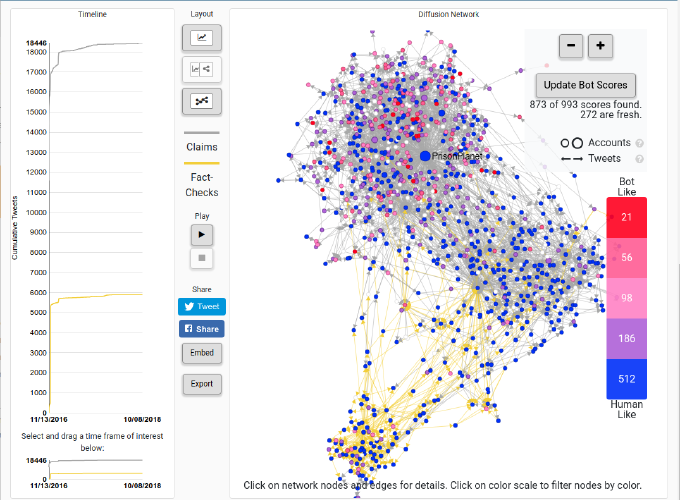Official Project Site
Description
Most American adults access the news through social media1. Massive amounts of low-credibility content have spread over social media before and after the 2016 US Presidential Elections despite intense fact-checking efforts. How do the spread of misinformation and fact-checking compete? What is the impact of social bots in the spread of low-credibility content? To explore these questions we built Hoaxy, a tool that visualizes the spread and competition of digital misinformation and fact-checking on Twitter. Hoaxy is an open platform that enables large-scale, systematic studies of how misinformation and fact-checking spread and compete on Twitter. Hoaxy captures public tweets that include links to articles from low-credibility and fact-checking sources. In follow up work, through integration with Botometer, a state-of-the-art social bot detection tool, Hoaxy is now capable of visualizing the impact of social bots on public Twitter conversations.
Hoaxy is part of the suite of tools of the Observatory on Social Media (OSoMe).
Software
Collaborators
- Chengcheng Shao (National University of Defense Technology, P. R. China),
- Filippo Menczer (Indiana University),
- Alessandro Flammini (Indiana University)
- Mihai Avram (Indiana University),
- Onur Varol (Indiana University, Northeastern University),
- Kaicheng Yang (Indiana University),
- Pik-Mai Hui (Indiana University),
- Lei Wang (Indiana University),
- Gregory Maus (Indiana University),
- Valentin Pentchev (Indiana University),
- Benjamin Serrette (Indiana University)
- Liang Chen
Funding
The project was supported by the Democracy Fund as part of the Prototype Fund organized by the John S. and James L. Knight Foundation.
- J. Gottfried, E. Shearer, News Use Across Social Media Platforms 2016, Pew Research Center (2016). Online at: http://www.journalism.org/2016/05/26/news-use-across-social-media-platforms-2016/ ^




